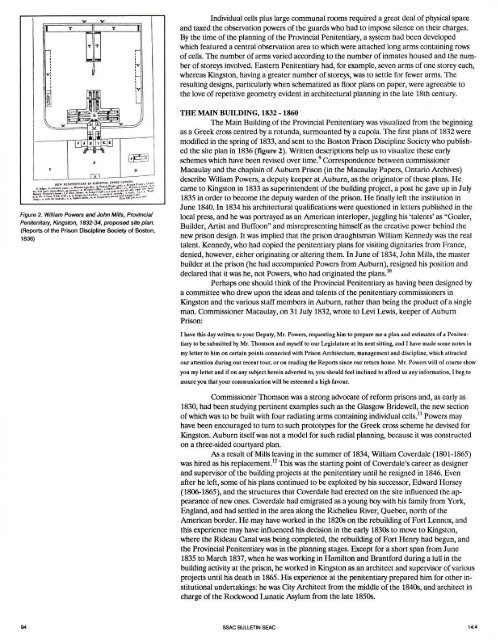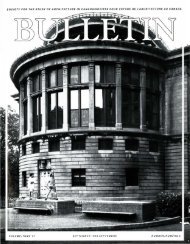society for the study of architecture in canada - SEXTONdigital
society for the study of architecture in canada - SEXTONdigital
society for the study of architecture in canada - SEXTONdigital
You also want an ePaper? Increase the reach of your titles
YUMPU automatically turns print PDFs into web optimized ePapers that Google loves.
T<br />
w<br />
T T<br />
w<br />
T<br />
Individual cells plus large communal rooms required a great deal <strong>of</strong> physical space<br />
and taxed <strong>the</strong> observation powers <strong>of</strong> <strong>the</strong> guards who had to impose silence on <strong>the</strong>ir charges.<br />
By <strong>the</strong> time <strong>of</strong> <strong>the</strong> plann<strong>in</strong>g <strong>of</strong> <strong>the</strong> Prov<strong>in</strong>cial Penitentiary, a system had been developed<br />
which featured a central observation area to which were attached long arms conta<strong>in</strong><strong>in</strong>g rows<br />
<strong>of</strong> cells. The number <strong>of</strong> arms varied accord<strong>in</strong>g to <strong>the</strong> number <strong>of</strong> <strong>in</strong>mates housed and .<strong>the</strong> number<br />
<strong>of</strong> storeys <strong>in</strong>volved. Eastern Penitentiary had, <strong>for</strong> example, seven arms <strong>of</strong> one storey each,<br />
whereas K<strong>in</strong>gston, hav<strong>in</strong>g a greater number <strong>of</strong> storeys, was to settle <strong>for</strong> fewer arms. The<br />
result<strong>in</strong>g designs, particularly when schematized as floor plans on paper, were agreeable to<br />
<strong>the</strong> love <strong>of</strong> repetitive geometry evident <strong>in</strong> architectural plann<strong>in</strong>g <strong>in</strong> <strong>the</strong> late 18th century.<br />
Figure 2. William Powers and John Mills, Prov<strong>in</strong>cial<br />
Penitenitary, K<strong>in</strong>gston, 1832-34, proposed site plan.<br />
(Reports <strong>of</strong> <strong>the</strong> Prison Discipl<strong>in</strong>e Society <strong>of</strong> Boston,<br />
1836)<br />
A I<br />
D<br />
THE MAIN BUILDING, 1832 - 1860<br />
The Ma<strong>in</strong> Build<strong>in</strong>g <strong>of</strong> <strong>the</strong> Prov<strong>in</strong>cial Penitentiary was visualized from <strong>the</strong> beg<strong>in</strong>n<strong>in</strong>g<br />
as a Greek cross centred by a rotunda, surmounted by a cupola. The first plans <strong>of</strong> 1832 were<br />
modified <strong>in</strong> <strong>the</strong> spr<strong>in</strong>g <strong>of</strong> 1833, and sent to <strong>the</strong> Boston Prison Discipl<strong>in</strong>e Society who published<br />
<strong>the</strong> site plan <strong>in</strong> 1836 (figure 2). Written descriptions help us to visualize <strong>the</strong>se early<br />
schemes which have been revised over time. 9 Correspondence between commissioner<br />
Macaulay and <strong>the</strong> chapla<strong>in</strong> <strong>of</strong> Auburn Prison (<strong>in</strong> <strong>the</strong> Macaulay Papers, Ontario Archives)<br />
describe William Powers, a deputy keeper at Auburn, as <strong>the</strong> orig<strong>in</strong>ator <strong>of</strong> <strong>the</strong>se plans. He<br />
came to K<strong>in</strong>gston <strong>in</strong> 1833 as super<strong>in</strong>tendent <strong>of</strong> <strong>the</strong> build<strong>in</strong>g project, a post he gave up <strong>in</strong> July<br />
1835 <strong>in</strong> order to become <strong>the</strong> deputy warden <strong>of</strong> <strong>the</strong> prison. He f<strong>in</strong>ally left <strong>the</strong> <strong>in</strong>stitution <strong>in</strong><br />
June 1840. In 1834 his architectural qualifications were questioned <strong>in</strong> letters published <strong>in</strong> <strong>the</strong><br />
local press, and he was portrayed as an American <strong>in</strong>terloper, juggl<strong>in</strong>g his 'talents' as "Goaler,<br />
Builder, Artist and Buffoon" and misrepresent<strong>in</strong>g himself as <strong>the</strong> creative power beh<strong>in</strong>d <strong>the</strong><br />
new prison design. It was implied that <strong>the</strong> prison draughtsman William Kennedy was <strong>the</strong> real<br />
talent. Kennedy, who had copied <strong>the</strong> penitentiary plans <strong>for</strong> visit<strong>in</strong>g dignitaries from France,<br />
denied, however, ei<strong>the</strong>r orig<strong>in</strong>at<strong>in</strong>g or alter<strong>in</strong>g <strong>the</strong>m. In June <strong>of</strong> 1834, John Mills, <strong>the</strong> master<br />
builder at <strong>the</strong> prison (he had accompanied Powers from Auburn), resigned his position and<br />
declared that it was he, not Powers, who had orig<strong>in</strong>ated <strong>the</strong> plans. 10<br />
Perhaps one should th<strong>in</strong>k <strong>of</strong> <strong>the</strong> Prov<strong>in</strong>cial Penitentiary as hav<strong>in</strong>g been designed by<br />
a committee who drew upon <strong>the</strong> ideas and talents <strong>of</strong> <strong>the</strong> penitentiary commissioners <strong>in</strong><br />
K<strong>in</strong>gston and <strong>the</strong> various staff members <strong>in</strong> Auburn, ra<strong>the</strong>r than be<strong>in</strong>g <strong>the</strong> product <strong>of</strong> a s<strong>in</strong>gle<br />
man. Commissioner Macaulay, on 31 July 1832, wrote to Levi Lewis, keeper <strong>of</strong> Auburn<br />
Prison:<br />
I have this day written to your Deputy, Mr. Powers, request<strong>in</strong>g him to prepare me a plan and estimates <strong>of</strong> a Penitentiary<br />
to be submitted by Mr. Thomson and myself to our Legislature at its next sitt<strong>in</strong>g, and I have made some notes <strong>in</strong><br />
my letter to him on certa<strong>in</strong> po<strong>in</strong>ts connected with Prison Architecture, management and discipl<strong>in</strong>e, which attracted<br />
our attention dur<strong>in</strong>g our recent tour, or on read<strong>in</strong>g <strong>the</strong> Reports s<strong>in</strong>ce our return home. Mr. Powers will <strong>of</strong> course show<br />
you my letter and if on any subject here<strong>in</strong> adverted to, you should feel <strong>in</strong>cl<strong>in</strong>ed to af<strong>for</strong>d us any <strong>in</strong><strong>for</strong>mation, I beg to<br />
assure you that your communication will be esteemed a high favour.<br />
Commissioner Thomson was a strong advocate <strong>of</strong> re<strong>for</strong>m prisons and, as early as<br />
1830, had been <strong>study</strong><strong>in</strong>g pert<strong>in</strong>ent examples such as <strong>the</strong> Glasgow Bridewell, <strong>the</strong> new section<br />
<strong>of</strong> which was to be built with four radiat<strong>in</strong>g arms conta<strong>in</strong><strong>in</strong>g <strong>in</strong>dividual cells. 11 Powers may<br />
have been encouraged to turn to such prototypes <strong>for</strong> <strong>the</strong> Greek cross scheme he devised <strong>for</strong><br />
K<strong>in</strong>gston. Auburn itself was not a model <strong>for</strong> such radial plann<strong>in</strong>g, because it was constructed<br />
on a three-sided courtyard plan.<br />
As a result <strong>of</strong> Mills leav<strong>in</strong>g <strong>in</strong> <strong>the</strong> summer <strong>of</strong> 1834, William Coverdale (1801-1865)<br />
was hired as his replacement. 12 This was <strong>the</strong> start<strong>in</strong>g po<strong>in</strong>t <strong>of</strong> Coverdale's career as designer<br />
and supervisor <strong>of</strong> <strong>the</strong> build<strong>in</strong>g projects at <strong>the</strong> penitentiary until he resigned <strong>in</strong> 1846. Even<br />
after he left, some <strong>of</strong> his plans cont<strong>in</strong>ued to be exploited by his successor, Edward Horsey<br />
(1806-1865), and <strong>the</strong> structures that Coverdale had erected on <strong>the</strong> site <strong>in</strong>fluenced <strong>the</strong> appearance<br />
<strong>of</strong> new ones. Coverdale had emigrated as a young boy with his family from York,<br />
England, and had settled <strong>in</strong> <strong>the</strong> area along <strong>the</strong> Richelieu River, Quebec, north <strong>of</strong> <strong>the</strong><br />
American border. He may have worked <strong>in</strong> <strong>the</strong> 1820s on <strong>the</strong> rebuild<strong>in</strong>g <strong>of</strong> Fort Lennox, and<br />
this experience may have <strong>in</strong>fluenced his decision <strong>in</strong> <strong>the</strong> early 1830s to move to K<strong>in</strong>gston,<br />
where <strong>the</strong> Rideau Canal was be<strong>in</strong>g completed, <strong>the</strong> rebuild<strong>in</strong>g <strong>of</strong> Fort Henry had begun, and<br />
<strong>the</strong> Prov<strong>in</strong>cial Penitentiary was <strong>in</strong> <strong>the</strong> plann<strong>in</strong>g stages. Except <strong>for</strong> a short span from June<br />
1835 to March 1837, when he was work<strong>in</strong>g <strong>in</strong> Hamilton and Brant<strong>for</strong>d dur<strong>in</strong>g a lull <strong>in</strong> <strong>the</strong><br />
build<strong>in</strong>g activity at <strong>the</strong> prison, he worked <strong>in</strong> K<strong>in</strong>gston as an architect and supervisor <strong>of</strong> various<br />
projects until his death <strong>in</strong> 1865. His experience at <strong>the</strong> penitentiary prepared him <strong>for</strong> o<strong>the</strong>r <strong>in</strong>stitutional<br />
undertak<strong>in</strong>gs: he was City Architect from <strong>the</strong> middle <strong>of</strong> <strong>the</strong> 1840s, and architect <strong>in</strong><br />
charge <strong>of</strong> <strong>the</strong> Rockwood Lunatic Asylum from <strong>the</strong> late 1850s.<br />
94<br />
SSAC BULLETIN SEAC t4:4

















